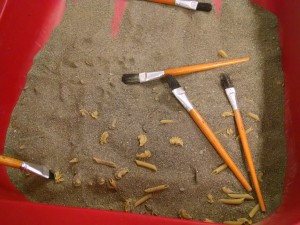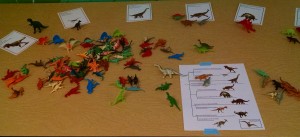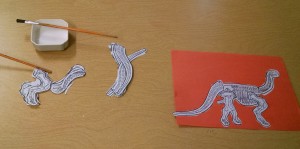Updated version of this post at https://inventorsoftomorrow.com/2017/01/23/dinosaurs-2/
How could you teach a kids’ science class and NOT include dinosaurs??
This was our week to touch on this topic – a perennial favorite for preschoolers. Here’s what we did:
Dress-Up / Imaginary Play: Most of our topics don’t really lend themselves to dress-up, so this was a chance to bring that in: we had dinosaur tails we made (like these), dino hood and gloves, and masks, plus roaring dinosaur hobby horses from the dollar store.
We also read the book I Am a Tyrannosaurus by Hines, and encouraged the kids to act out different dinosaurs as the book describes. And we set out a collection of toy dinosaurs, toy trees, and wooden blocks for kids to build scenes with.
Science Exploration
Dino Dig: There’s lots of ways you could have children “dig” for dinosaurs (Party Ideas by a Pro recommends casting plaster dinos and burying them in sand.) We kept it easy (easy to set up and easy to clean up) by filling a plastic tub full of shredded paper and then burying plastic dinosaurs in it to dig up. (I’ve also done it with shredded paper in a cardboard box and we hid wooden dinosaur skeleton puzzles that we had pre-assembled and glued together. Kids love this simple activity!
Dino Bones in the Sensory Tub: We buried dried pasta in sand in the sensory tub and gave them paint brushes to clean the “bones” with and sort them into a dish. I will note that we put in too many noodles – they were too easy for the kids to find – it would have been more fun if they’d had to hunt for them. Also, they were a lot of work to get OUT of the sand when it was time for clean-up. (We wanted to save the sand for later use in other projects, so needed to get out all the noodles.) There are also a variety of “dinosaur bones” you can buy that could be buried, but I like this for the fact that they’re easy and cheap materials for anyone to use.
Making fossil impressions: We made play-dough. We put play-dough in the bottom of a paper bowl, then pressed noodles into it and removed them, leaving an impression (you could also use shells, leaves, pine needles, or other items to make impressions.)
Footprints: We cut out large dinosaur footprints. Then we had kids trace their own footprints and cut them out and compare them to the size of the big footprint. Then they could decorate the footprints. (We also had in the room a paper tracing of a real triceratops footprint, that was about 3 foot by 3 foot.)
Sorting Activity: I made up a dinosaur family tree, plus 10 cards describing categories of dinosaurs. (See my sample cards. Note: I do not have copyright permission to the images included, so you should find your own images to use for your cards.) We set them out on a table, along with a big pile of plastic dinosaurs and encouraged kids to sort them into categories.
Art
Molded Dinosaurs: We had plastic molds of dinosaurs that kids pressed air drying clay in to make take-home dinosaurs. (On Amazon, search for “dinosaur molds” and you’ll find several options.)
Rubbings: We had plastic rubbing plates that kids could lay paper over and use crayons to make rubbings of birds and reptiles.
Make a Triceratops Mask: With a paper plate, paper triangles, and popsicle sticks.
Assemble a paper skeleton / add pasta bones: We printed out materials from Prekinders. We cut some out in advance, so the younger kids could just assemble a skeleton, while the older kids were encouraged to use their scissor skills cutting out the pieces and assembling them on a paper. After gluing together the paper skeleton, kids were given the option of adding noodle “bones” to their picture.
Outdoor Activity: Search for Signs of Wildlife: Once a month, our class meets at a park with nature trails, and we do a nature-based activity. This month, we talked about how you could tell an animal had been in the woods: if you saw tracks, scat, signs that animals had been eating (like stripped bark or chewed leaves), homes (spider webs, nests, etc.) and eggs. We looked for signs of real animals, but also signs that a dinosaur had been in our woods.
I found pictures of items online, printed and laminated them, and hid them in the woods. We found t-rex footprints, sauropod footprints, dinosaur poop (really a picture of crocodile dung), dinosaur eggs (a photo of an alligator nest), and a photo of chewed up leaves. (Here’s a pdf of the photos I used, but again, I don’t have copyright privileges for these images, so would encourage you to find your own.)
I wanted to take the kids to a clearing in the woods, but when I checked it before class, I found that there was a lot of trash there. I took the kids there anyway, and used it as an opportunity to talk about the fact that animals sometimes leave waste behind, because they can’t help it. But, we as humans can choose to leave no trace – picking up and carrying out all our trash. We cleaned up the clearing before returning to the classroom.
Other ideas
TP roll skeleton: I like this idea of using toilet paper rolls and paper towel rolls to lay out a dinosaur skeleton: www.yourmodernfamily.com/dinosaur-out-of-toilet-paper-rolls/
Make salt dough bones: For an ambitious project, try making your own set of dinosaur bones out of salt dough. Then the children can use them to assemble skeletons. http://kitchenfloorcrafts.blogspot.com/2014/07/homemade-dinosaur-bones.html
Big Ideas
In circle time, you’ll discover that you have some kids who know next to nothing about dinosaurs, and others that know more than most adults! There’s a few messages that should be made clear to all.
- First, dinosaurs are extinct. They lived a really long time ago, but they are not alive now. The closest thing we really will see is a crocodile or an alligator, although birds are also descendants of dinosaurs.
- They weren’t ALL really big. Some dinosaurs were the size of a chicken.
- The way we know about dinosaurs is by finding and digging up bones and fossil evidence, and then attempting to assemble them into full skeletons and gather data about things like what they ate, how they walked, and so on.
- When talking about dinosaurs, it’s pretty hard to avoid the idea that some dinosaurs lived by eating other dinosaurs. Parents can sometimes get skittish about the “violence” of dinosaurs, especially since movies make millions of dollars by showcasing this violence. But you can also be pretty matter of fact about it. Just as we can say “frogs eat bugs” or “eagles eat mice”, we can address that carnivorous dinosaurs ate other dinosaurs.
Books
There must be hundreds of children’s books about dinosaurs! And believe me, I’ve read most of them when my son was three… we’d walk to the library twice a week and bring home a giant stack of nothing but dinosaur books. (If you live in King County, and you don’t know how to go online and put books on hold for pick up at your local library, go to the library now and learn how!!! It’s just as easy as ordering from Amazon… go online to http://www.kcls.org, search for any book you want, place a hold on it, and in about 2 – 4 days, you’ll get an email saying it’s ready for pick-up at the library branch you chose. In the library, they’re set aside on special shelves, and it takes just minutes to pick them up. We get literally 100’s of books a year this way, including every single book I’ve talked about on this blog. If you prefer ebooks, you can also check out plenty at ebooks.kcls.org.)
Here’s photos of just a few dinosaur books.
Here’s some good overviews that I would recommend for varying age groups. They cover basic ideas like what dinosaurs are and how scientists know about them.
Dinosaurs, Dinosaurs by Barton. The best dinosaur book for toddlers, age 2 – 4. Simple primary color illustrations and simple text.
Let’s Talk About Dinosaurs by Teckentrup. Good for ages 3 – 6, although we skipped some pages when we read it in circle.
Digging Up Dinosaurs by Aliki. A nice overview of both dinosaurs and paleontology: now how bones are excavated and transported to museums. Too long to read in a group circle time, but good for reading to a 4 – 6 year old one-on-one.
Dinosaurs! by Gibbons. A nice overview of dino facts, at a level preschoolers can follow but kids age 5 to 7 will also like.
In addition to all the non-fiction books, dinosaurs also feature prominently in LOTS of story books. Dinosaur Roar by Strickland is not educational, but it’s one of my very favorite books to read aloud. Captain Raptor by O’Malley is entertaining space opera with dinosaurs. Also check out When Dinosaurs came with Everything.
Videos
Again, there are LOTS of TV shows and movies that incorporate dinosaurs. Many kids love Dinosaur Train on PBS, and the Land Before Time series of movies. When my son was four, he loved Walking with Dinosaurs from the BBC. It’s done like a nature documentary, and it doesn’t shy away from the fact that some dinosaurs eat other dinosaurs, so it might be frightening for some little ones, but will work well for others, and they definitely did their research to get things as scientifically correct as possible. On YouTube, you can find “Andy’s Dinosaur Adventures” from cbeebies, which is also documentary style, but a little sillier / kid-friendly. (Both these shows do a good job of animating dinosaurs, and it might make your child think that dinosaurs are actually living somewhere on the planet now, so you may need to clarify extinction.)
There are also countless videos on YouTube if you search for “dinosaur songs for kids.” I have some of the ones we liked on a playlist here: https://www.youtube.com/playlist?list=PLsMLXfBPSxoH237JM_1fC_VKrMgwNVqLf















[…] dinosaur dig, with dinosaurs buried in materials from the office […]
LikeLike
[…] at that station, you’ll make a container to protect an egg, and then try dropping it.” The “Dino Dig” is better than “go rummage through that shredded paper and find the plastic […]
LikeLike
[…] Check out all my other posts on this blog about teaching STEM concepts. They are organized around weekly theme, but almost all the themes include a sorting activity! Examples: Solid, Liquid, or Gas? Can the Wind Move It? Rock sorting and dinosaur sorting. […]
LikeLike